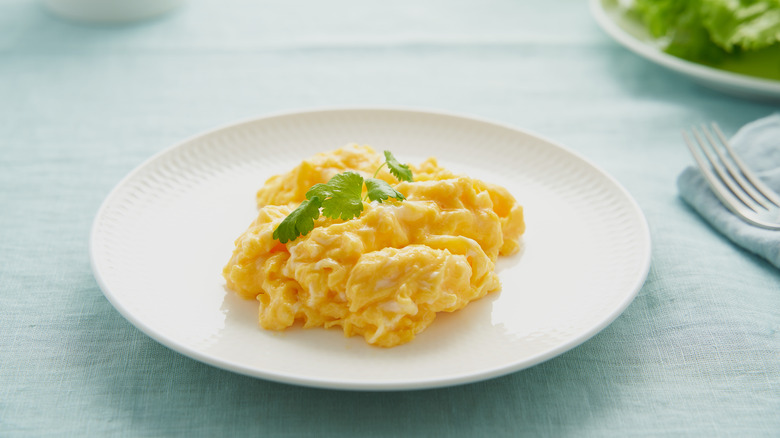Alton Brown's Simple Trick For Keeping Scrambled Eggs Warm
If there's a kitchen staple more versatile than the incredible, edible egg, we'd be hard-pressed to think of one. Whether you're frying a simple sunny side up or omelet, or whipping up a more complex dish such as a spinach frittata or eggs Benedict — not to mention all the baked goods and desserts in which eggs play such an important role — eggs are found in so many of the dishes we prepare day in and day out, in both their sweet and savory iterations.
But let's be honest: Most of us who love eggs typically fall into a rut and make the same egg dish time and again, whether out of habit or simply because we like it so much. For many of us, that dish is scrambled eggs: A reliable, easy-to-make staple that requires little more than a nonstick pan, a pat of butter, and some salt (via Inspired Taste). Scrambled eggs are a perennial favorite among Americans, with a Daily Kos poll finding that 22% of participants prefer to make their eggs that way, second only to over easy with 24%.
Scrambled eggs make a quick, easy, and reliable breakfast — but have you ever noticed that they go cold on the plate in, like, six seconds? Thankfully, Alton Brown has a solution for that.
Serve scrambled eggs on a warmed plate
Few would argue against the fact that scrambled eggs are delicious, but the dish tends to present one pesky problem that can be seriously annoying: Even when they're served piping-hot, scrambled eggs go cold once they're plated. This can be distressing when you want to sit down to a warm, comforting breakfast, but luckily, chef and Food Network host Alton Brown has a hack that will keep your scrambled eggs at the perfect temperature.
It's no surprise that the culinary mind behind so many "Good Eats" episodes would offer a simple and functional solution to keeping scrambled eggs warm, and all it involves is a warm plate. "Odds are you're going to be serving these on a plate," Brown notes in his recipe for Perfect Scrambled Eggs. "If so, I strongly suggest you park an ovensafe one in a low oven or in hot water while you're cooking. Cold plates suck the heat right out of food."
While few of us would think to warm plates at home, it's a common practice in restaurants, which typically use heating lamps to keep dinner plates warm, according to Just Restaurant Supplies. But as Brown points out, us home cooks can simply slip plates into a hot water bath — Domestic Goddess and fellow Food Network host Nigella Lawson suggests a five minute soak time — or place them in a 200 degree Fahrenheit oven or toaster oven for five minutes before eating (via People).

